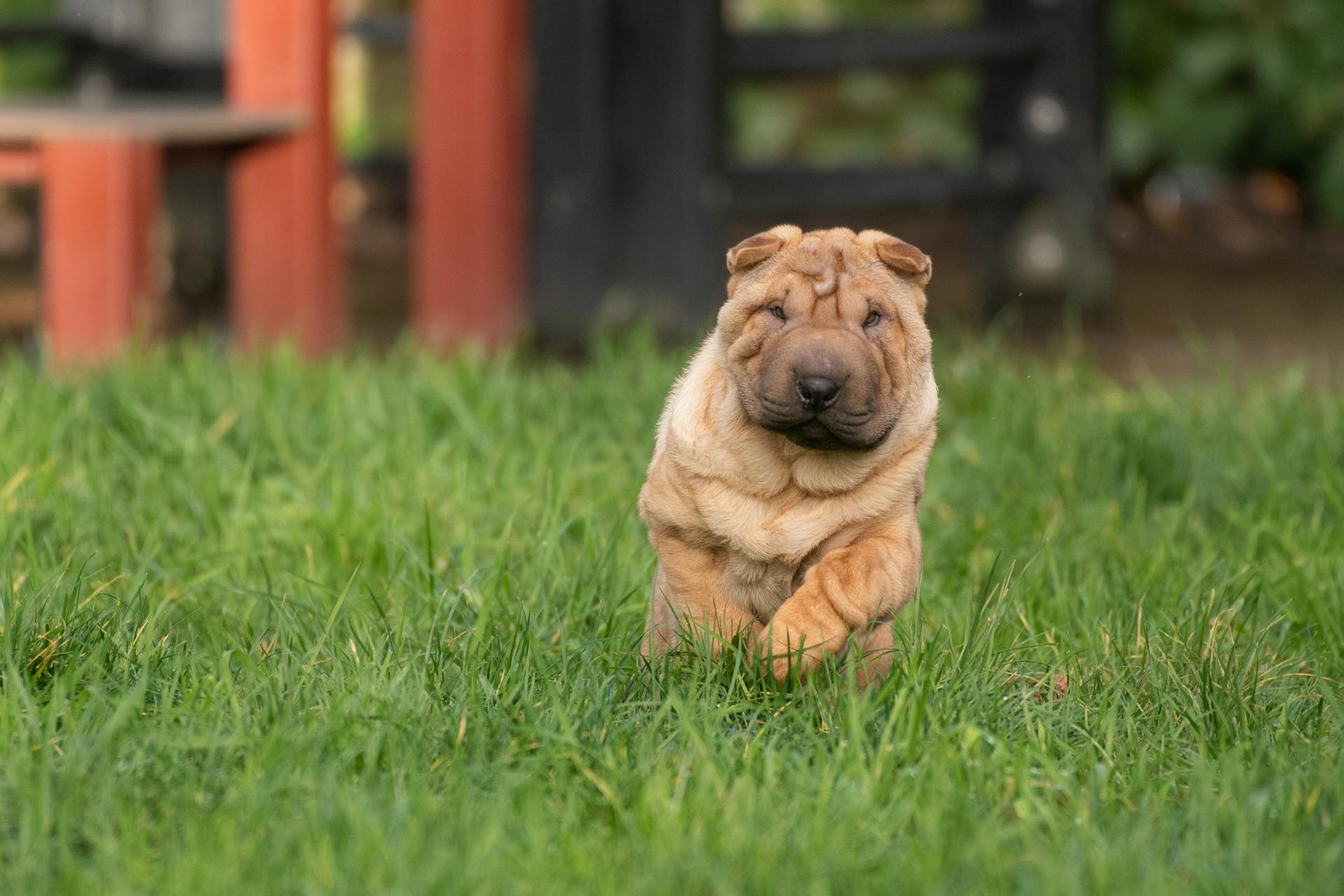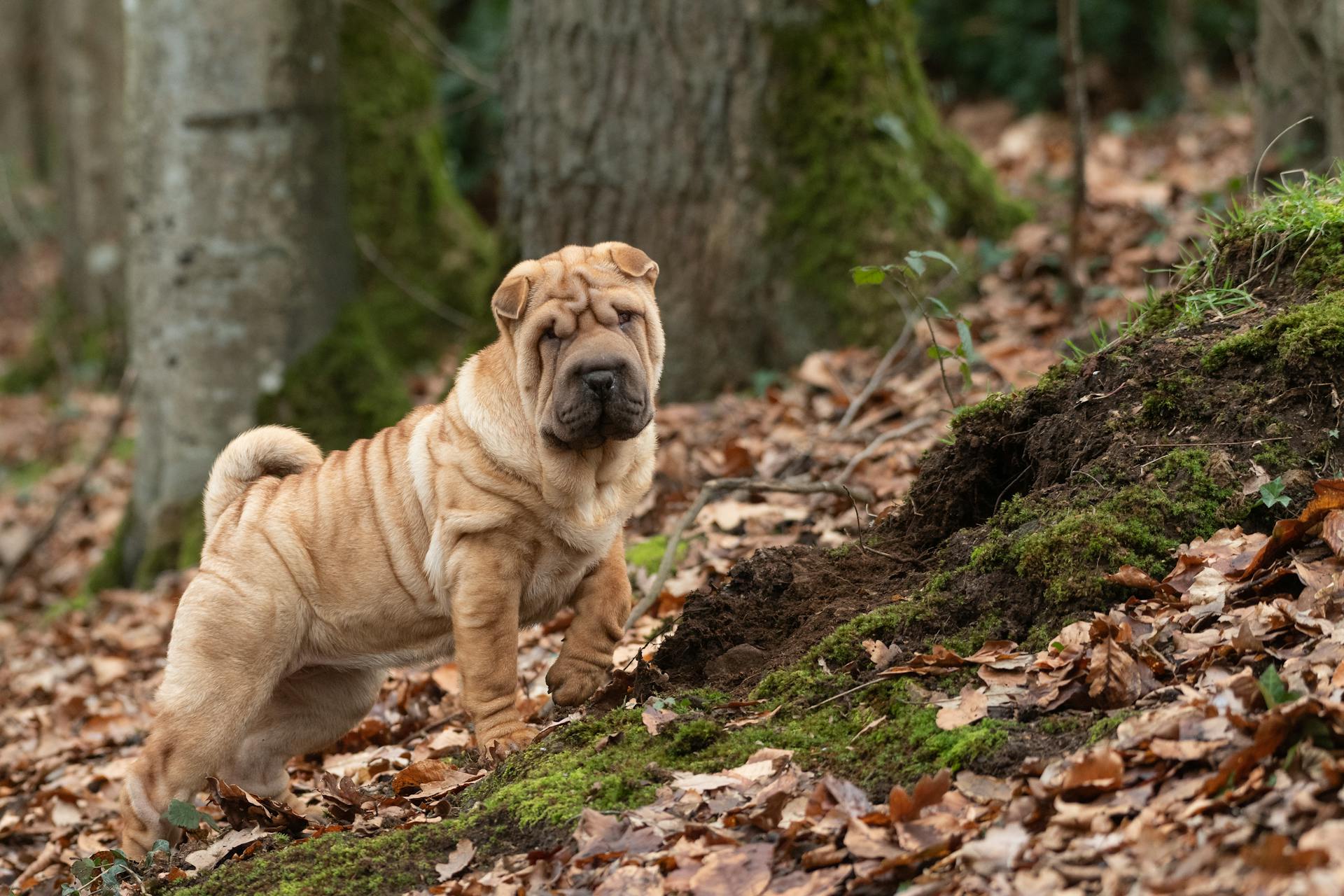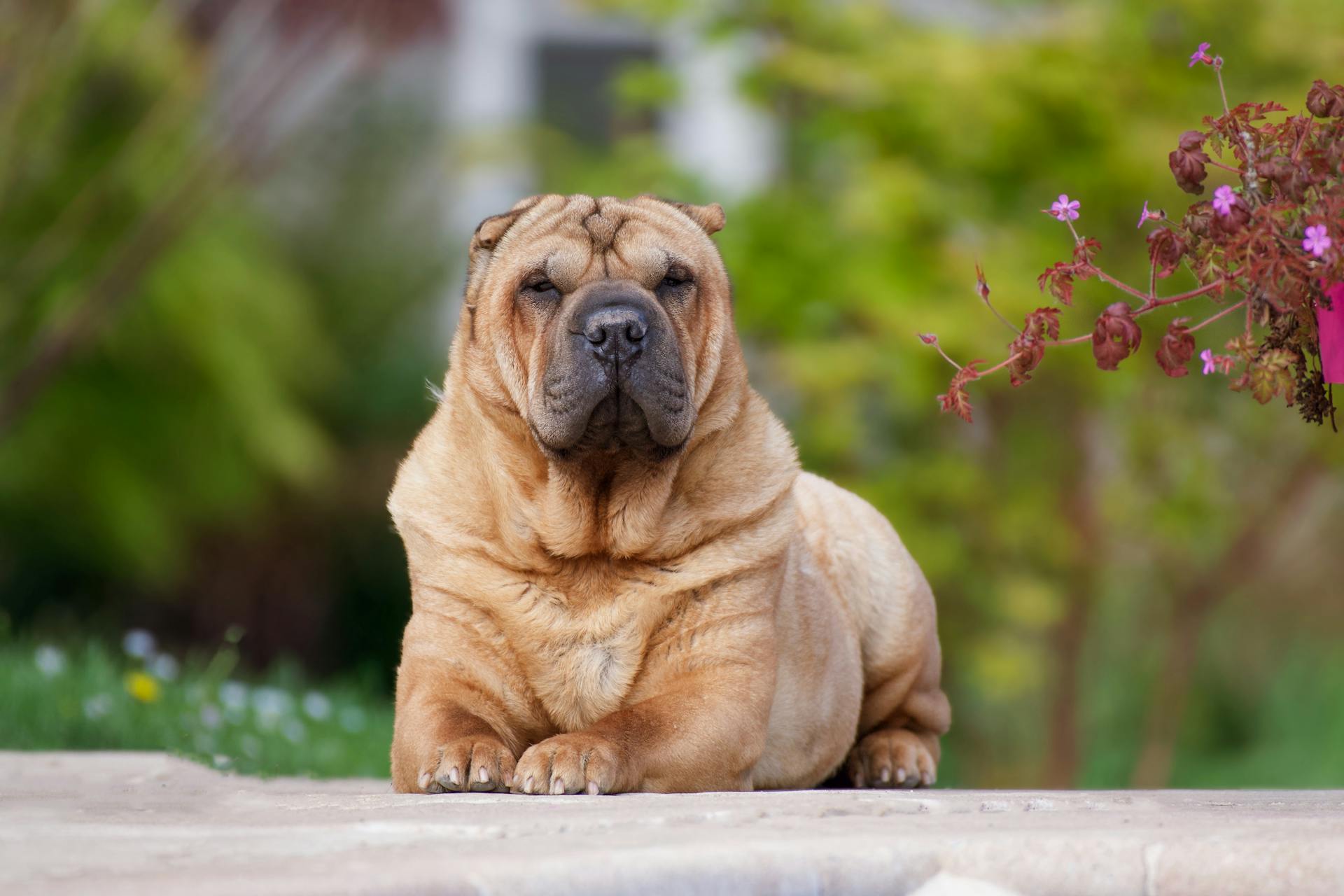
The Shar Pei is a loyal and loving companion, but it's essential to understand their characteristics and needs to provide the best care.
They are a relatively small breed, weighing between 25 and 45 pounds, and standing between 16 and 19 inches tall.
Their short, easy-to-maintain coat requires minimal grooming, but it does come in a variety of colors, including cream, black, and fawn.
Shar Peis are known for their distinctive wrinkled skin, which requires regular cleaning to prevent skin problems.
Care and Health
The Chinese Shar-Pei is a unique breed that requires some special care and attention. They need a moderate walk or game session every day, and their coat, whether rough, smooth, or bushy, requires only weekly brushing.
Their deep wrinkles and folds need to be inspected often and cleaned regularly to prevent irritation or skin-fold pyoderma. This is especially important as Shar-Pei fever, a disorder that affects about one in four Shar-Pei dogs, can cause amyloidosis and kidney failure.
Shar-Peis are generally not good in dog parks due to their aggression towards strange animals, and they may not be skilled in agility or obedience trials. However, they may enjoy lure coursing and nose work.
Here are some key health concerns to watch out for:
- Shar-Pei fever, which can cause amyloidosis and kidney failure
- Entropion (inturned eyelids)
- Hip dysplasia
To keep your Shar-Pei healthy, make sure to:
- Supervise them as you would a toddler, keeping doors closed and blocking off rooms as necessary
- Brush their coat at least weekly
- Clean their ears weekly
- Clean and dry their deep wrinkles and folds often
- Feed a high-quality diet appropriate for their age
- Exercise them regularly, but don't overdo it at first
By following these tips and being aware of the potential health concerns, you can help your Chinese Shar-Pei live a happy and healthy life.
Skin and Coat
Your Shar-Pei is prone to skin infections, particularly lip-fold pyoderma, which occurs in the moist folds of skin along the lower jaw. This can cause a reddened, smelly area that's uncomfortable for your dog.
Regular check-ups with your veterinarian are essential to catch this problem early, and we'll recommend treatment with antibiotics as necessary. In severe cases, excess skin folds can be surgically removed.
The Shar-Pei is also predisposed to several skin conditions, including allergic skin disease, cutaneous mucinosis, intertrigo, otitis externa, and vasculopathy. These conditions can be more common in Shar-Peis than in other breeds.
A review of over 23,000 records found that 7.7% of Shar-Peis have atopic dermatitis, which is higher than the overall rate. This highlights the importance of monitoring your dog's skin health closely.
To minimize shedding, your Shar-Pei's short coat should be brushed once a month. This is a great opportunity to bond with your dog and keep their coat looking its best.
Feeding and Nutrition
The daily diet of a Shar-Pei should consist mostly of dog food, with only 10% being treats, and it's best to follow the feeding guidelines on the dog food packaging.
A Shar-Pei's daily food intake is between 1.5 to 2.5 cups of high-quality dry food a day, divided into two meals.
You should consult your veterinarian to determine the proper portion size to feed your Shar-Pei, based on their ideal body weight and life stage.
A Shar-Pei should be fed two meals a day, one in the morning and one in the evening.
Baby carrots are a healthy treat you can feed your Shar-Pei, but try to avoid feeding them other types of people food.
Shar-Peis are prone to skin issues, so an omega-3 fatty acid supplement can help support the skin barrier and prevent dandruff.
You should transition your puppy's diet over five to seven days to an adult medium-breed dog formula when they turn 1 year old.
At 7 years of age, a Shar-Pei should be transitioned to a senior diet that contains joint support.
You should measure out the food for each meal to ensure you're feeding your pup the proper amount.
Behavior and Training
Shar-Pei behavior can be challenging, especially if they're not socialized at an early age. They may display fear aggression in unfamiliar situations, making vet visits a nightmare if not introduced to the environment properly.
To prevent this, give your Shar-Pei positive reinforcements like praise and treats at each vet visit. This will make the experience enjoyable for both you and your dog.
Shar-Pei are smart, but they can be stubborn, so start training them when they're young and use positive rewards like praise and treats. Basic cues like "sit", "stay", and "come" are essential, and ideally, they should take socialization and obedience training classes with a professional pet trainer.
Their independent nature makes training a challenge, requiring a firm and consistent training regime. This breed is generally friendly towards household pets, but can be aggressive towards strange dogs and aloof or suspicious towards strangers.
Care and Lifestyle
Living with a Chinese Shar-Pei requires attention to their specific needs and personality traits. They're not naturally friendly to other dogs and can be stubborn, so consistent training and socialization are a must.
Their short noses make them sensitive to heat, so it's essential to keep them indoors with fans or air conditioning in hot weather. They can be aggressive toward other dogs, so keeping them leashed in public is a good idea.
A daily walk or play session is necessary to keep them happy and healthy. However, they can be prone to overheating, so be sure to take breaks and provide plenty of water.
Their coat is generally easy to care for, but it's crucial to brush it weekly and clean their deep wrinkles daily to prevent infections. Regular ear cleaning is also essential, especially for puppies.
Shar-Peis are laid-back dogs that don't require much exercise, but they do need regular mental stimulation to prevent anxiety and fear-based behaviors. Early training and socialization are key to preventing these issues.
Here are some specific care and lifestyle considerations for Shar-Pei owners:
Overall, with the right care and attention, Chinese Shar-Pei can make wonderful companions for experienced pet owners.
Behavior and Training
Shar-Pei dogs can display fear aggression if they're put into unfamiliar situations that make them anxious.
They're intelligent, but can be stubborn, so start training early and give them positive rewards like praise and treats. Teaching basic cues like "sit", "stay", and "come" is crucial.
Socialization is key to helping Shar-Pei puppies feel comfortable in new situations. Enroll them in puppy kindergarten classes and invite visitors over regularly.
Shar-Pei dogs are generally happy in small spaces like apartments or condos, as long as they get daily exercise. They appreciate going for short walks or engaging in other low-key activities.
To prevent heat stroke, keep your Shar-Pei indoors with fans or air conditioning in hot weather. Their short noses make them sensitive to heat.
Consistent and firm training is necessary to establish leadership and prevent unwanted behaviors. Shar-Pei dogs are eager to please, but can be stubborn at times.
Shar-Pei dogs can be aggressive toward other dogs, so it's best to keep them leashed in public. They're generally friendly toward household pets, but can be aloof or suspicious around strangers.
Early socialization is essential to prevent Shar-Pei dogs from becoming overly shy or overprotective. Take them to puppy classes, outdoor events, and busy parks as often as possible.
Shar-Pei dogs have a moderate to high prey drive, so introduce them to cats and small animals at a young age to prevent chasing or herding behaviors.
With proper training and socialization, Shar-Pei dogs can make great companions for experienced pet owners.
Health Issues
As a Shar Pei owner, it's essential to be aware of the potential health issues that can affect your furry friend. Shar Peis are prone to skin infections, particularly lip-fold pyoderma, which can cause redness, swelling, and a foul odor.
Regular ear cleaning is crucial to prevent ear infections, as Shar Peis are more susceptible to this issue due to their narrow ear canals.
Allergies are common in Shar Peis, causing skin irritation, itching, and excessive licking. Be on the lookout for signs such as licking paws, rubbing the face, and frequent ear infections.
Eye problems are also prevalent in Shar Peis, with conditions like glaucoma, cherry eye, and entropion posing a risk to your dog's vision and overall health.
Mast cell tumors are a type of skin cancer that can affect Shar Peis, and early detection is critical for successful treatment.
Respiratory distress syndrome, also known as brachycephalic syndrome, can cause breathing difficulties and other issues due to the breed's short nose and narrow airway.
Shar Peis are also prone to skin conditions such as atopic dermatitis, juvenile onset demodicosis, and pododermatitis, which can cause inflammation, infection, and discomfort.
Here are some common health issues that can affect Shar Peis:
- Allergies
- Ear infections
- Eye problems (glaucoma, cherry eye, entropion)
- Mast cell tumors
- Respiratory distress syndrome
- Skin conditions (atopic dermatitis, juvenile onset demodicosis, pododermatitis)
It's essential to work closely with your veterinarian to monitor your Shar Pei's health and address any potential issues early on. Regular check-ups, vaccinations, and preventative care can go a long way in ensuring your furry friend lives a happy and healthy life.
Care and Upkeep
The Chinese Shar-Pei is a wonderful breed, but they do require some special care to keep them happy and healthy. They need a moderate walk or game session every day, and it's essential to keep them from overheating.
Their coat is generally easy to care for, requiring only weekly brushing. However, it's crucial to inspect their deeper folds and wrinkles daily and clean and dry them regularly to avoid irritation or skin-fold pyoderma.
Worth a look: Shih Tzu Puppy Care
Shar-Pei fever is a significant health concern, affecting roughly one in four dogs. It's essential to monitor your Shar-Pei for fever and signs of swelling, especially on the ankle joints and muzzle, and treat them medically to reduce the body's temperature and amyloid production.
Here are some essential care tasks to include in your Shar-Pei's daily routine:
- Brush their coat weekly
- Clean their ears weekly
- Clean and dry their deep wrinkles daily
- Brush their teeth at least twice a week
Remember, a Shar-Pei's diet and exercise routine are also crucial for their overall health. They need a high-quality diet appropriate for their age, and regular exercise, but not too much, especially in warm weather.
Size and Life Expectancy
The Shar Pei is a compact breed, with both males and females typically having a height ranging from 18 to 20 inches. Their weight is also relatively manageable, with a range of 40 to 55 pounds.
In terms of life expectancy, the Shar Pei has a slightly shorter lifespan compared to other breeds. A 2024 study found that the breed's life expectancy is 10.6 years, which is lower than the average of 12.7 years for purebreeds and 12 years for crossbreeds.
Recommended read: 100 Years Ago Original Boston Terrier
Size

The Chinese Shar-Pei is a relatively compact breed, with males and females typically having a height ranging from 18 to 20 inches.
Both males and females typically weigh between 40 and 55 pounds.
Their small size makes them a great fit for city living or for families with smaller yards.
Life Expectancy
Life expectancy can vary significantly between breeds. A 2024 study in the UK found a life expectancy of 10.6 years for the breed compared to an average of 12.7 for purebreeds.
In comparison, crossbreeds have a slightly lower life expectancy of 12 years on average. This highlights the importance of understanding the specific needs of your pet.
The study suggests that the breed's life expectancy is lower than average, which may impact your decision to bring one home.
See what others are reading: How Long Do Boston Terrier Dogs Live
History and Overview
The Shar Pei is an ancient breed with a rich history in China, where they were valued as hunters, herders, guardians, and fighters. They were first bred in the southern provinces of China.
A different take: Tibetan Mastiff China
The Shar Pei's unique appearance, with its wrinkled skin and short, bristly coat, served a functional purpose. Their loose skin allowed them to wriggle free if caught by an opponent while hunting.
The breed was once very popular, but war and political turmoil in China in the 20th century took its toll, and by the 1970s, the Shar Pei was close to extinction. Only 60 Shar Peis remained, earning them the title of the world's rarest breed.
In the 1970s, a Hong Kong businessman named Matgo Law appealed to the international community to help save the breed. Thanks to his efforts, a small number of Shar Peis were brought to the United States, and breed fanciers formed the Chinese Shar-Pei Club of America, Inc., in 1974.
The Shar Pei's popularity led to unscrupulous breeding, resulting in dogs with a "meat-mouth" type, which is distinct from the original "bone-mouth" type. Today, only 50 to 100 examples of the traditional bone-mouth type remain.
Here are some key facts about the Shar Pei's history:
- Originated in southern China
- Valued as hunters, herders, guardians, and fighters
- Once very popular, but nearly extinct by the 1970s
- Rescued by Matgo Law and breed fanciers in the 1970s
- Two types: "bone-mouth" and "meat-mouth"
The Shar Pei's independent nature and strong will require early training and socialization. With proper care and attention, they can make loving and loyal family pets.
Rescue and Organizations
If you're considering bringing a Shar-Pei into your family, it's essential to think carefully about the responsibilities involved.
There are many Shar-Peis in need of adoption and fostering, so it's worth considering contacting a rescue group before visiting a breeder. You can find reputable rescue groups through organizations like the Chinese Shar-Pei Club of America National Rescue Trust.
If you're unsure about owning a Shar-Pei, contacting a rescue group can be a great way to learn more about the breed and get a sense of what's involved.
- Chinese Shar-Pei Club of America National Rescue Trust
- Pei People Shar-Pei Rescue
- North American Shar-Pei Rescue
Rescue Groups
Rescue Groups are a great way to find a new furry friend while also helping a dog in need. Many Shar-Peis end up in shelters due to owner irresponsibility or other unfortunate circumstances.
You can find Shar-Peis in need of adoption through rescue groups, which often have a better understanding of the breed's needs than breeders. This can be especially helpful if you're new to dog ownership.
You might like: New Dog Breed Lancashire Heeler
If you're considering adopting a Shar-Pei, consider contacting a rescue group first. They can help match you with a dog that's a good fit for your lifestyle.
Some notable rescue groups for Shar-Peis include the Chinese Shar-Pei Club of America National Rescue Trust, Pei People Shar-Pei Rescue, and North American Shar-Pei Rescue.
Here are some specific rescue groups to consider:
- Chinese Shar-Pei Club of America National Rescue Trust
- Pei People Shar-Pei Rescue
- North American Shar-Pei Rescue
Breed Organizations
Reputable breeders are committed to breeding healthy, well-socialized puppies.
Reputable breeders screen their breeding stock for health problems and socialize their puppies from a young age. This ensures that puppies will make great companions.
Backyard breeders, on the other hand, prioritize making a profit over producing healthy, well-adjusted dogs.
Puppies from backyard breeders are more likely to have health problems and behavioral issues due to inadequate breeding practices.
Frequently Asked Questions
Is a Shar-Pei a good family dog?
Yes, the Chinese Shar-Pei is a loyal companion to family, making them a great addition to many households. However, their independent nature may require extra attention and socialization to ensure they thrive in a family environment.
Do Shar Peis like to cuddle?
Shar Peis can be affectionate and enjoy cuddling, but it's largely dependent on individual personalities and bond strength. Some Shar Peis form strong bonds with their owners, making them more likely to cuddle.
Why are Shar Peis so rare?
Shar Peis were nearly extinct due to a lack of interest in keeping them as pets in communist China. However, thanks to one dedicated breeder, Matgo Law, the breed was preserved and is now a beloved companion.
Is A Shar-Pei A Chinese dog?
Yes, the Chinese Shar-pei is a breed that originated in China, with a rich history as farm dogs and guardians. This ancient heritage is reflected in their loyal and independent nature.
What does Shar-Pei mean in Chinese?
The Chinese term "Shar-Pei" literally translates to "sand-skin" or "rough, sandy coat". This name refers to the breed's unique, textured coat.
Featured Images: pexels.com


